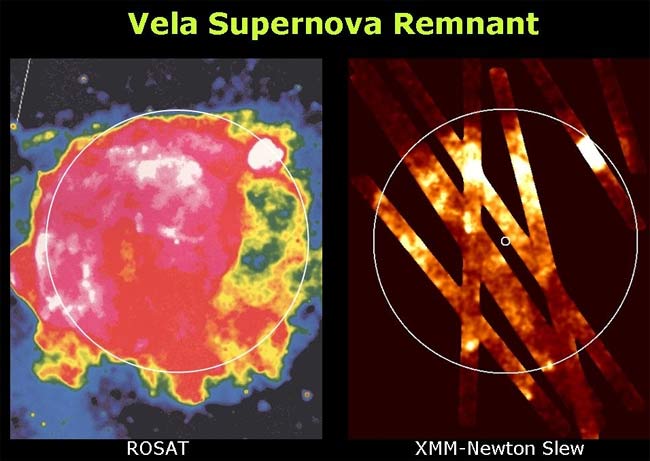Space Telescope Performs Extra Sky Survey

Astronomers have squeezed an extra mission out of the European Space Agency's XMM-Newton X-ray observatory by having it keep its cameras open while switching between different targets. The result is a "free-of-charge" survey that has mapped an impressive 25 percent of the sky.
As it moves around the Earth in its highly elliptical orbit, astronomers point XMM-Newton's telescope towards specific regions of the sky. The 3.8-tonne satellite "slews," or rotates, slowly, at a rate of about 90 degrees per hour.
As it turns to refocus its attention, objects such as stars and galaxies stream past the telescope's field of view for about ten seconds only. Despite this brief amount of time, the wide collecting area of the XMM-Newton's mirrors and the efficiency of its image sensors allow it to detect thousands of X-ray sources.
By comparing XMM-Newton's survey data with those obtained over a decade ago by the international ROSAT mission, scientists can now study the long-term stability or evolution of about two thousand objects in the sky.
Initial results suggest that some sources have varied their brightness levels by incredible amounts. The most extreme of these are variable stars whose luminosities change due to either physical process, such as pulsations or eruptions, or because of eclipses and stellar rotations.
More surprisingly, XMM-Newton detected individual galaxies that varied their brightness levels as well; scientists think the change may be due to large amounts of matter being consumed by the supermassive black holes that lie at these galaxies' centers.
The slewing technique has proven to be more efficient than traditional pointed observations at imaging very large sky features in their entirety, which require huge amounts of telescope-time. One such object already been imaged is the 20,000 year-old Vela supernova remnant, which occupies a sky area 150 times larger than the full moon.
Breaking space news, the latest updates on rocket launches, skywatching events and more!
The multiple, quick passes are also sensitive enough to record the detailed light spectrum of extremely bright, low-mass X-ray binary star systems, which are powered either by matter being sucked from normal stars onto the surface of a neutron stars, or by matter being consumed by black holes.
Earlier this month, XMM-Newton scientists released some of the initial high quality, processed data obtained using the slewing technique so far. So far, about 55 percent of the catalogued entries have been identified with known stars, galaxies, galaxy clusters and quasars.
The 33-foot (10 meter) long XMM-Newton was launched in 1999 and carries the most sensitive telescope mirrors in the world, which are made of roughly 2,150 square feet (200 square meters) of polished gold. The observatory's 48-hour orbit takes it nearly one third the distance to the Moon, which carries it outside the radiation belts surrounding the Earth.
- Early Images From XMM-Newton Telescope on 1st Birthday
- Europe's Multi-Mirror X-Ray Space Telescope Takes First Pictures
- Timeline: 40 Years of X-ray Astronomy
Ker Than is a science writer and children's book author who joined Space.com as a Staff Writer from 2005 to 2007. Ker covered astronomy and human spaceflight while at Space.com, including space shuttle launches, and has authored three science books for kids about earthquakes, stars and black holes. Ker's work has also appeared in National Geographic, Nature News, New Scientist and Sky & Telescope, among others. He earned a bachelor's degree in biology from UC Irvine and a master's degree in science journalism from New York University. Ker is currently the Director of Science Communications at Stanford University.
